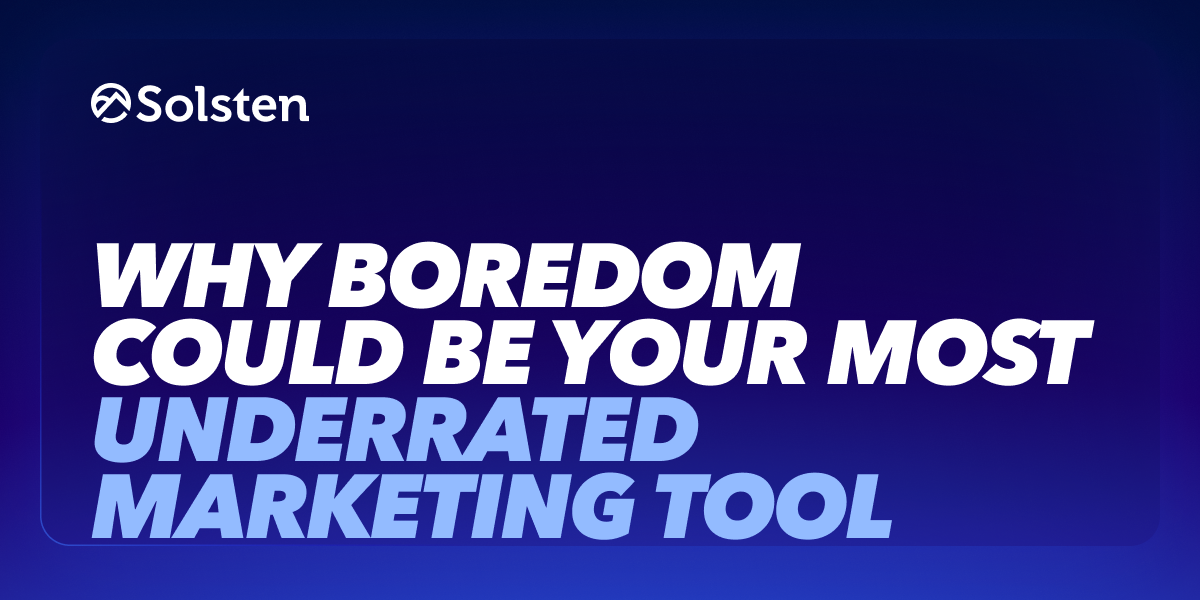Reclaiming the Forgotten State That Drives Game-Changing Creativity
We live in the golden age of attention – and yet, our attention spans are bankrupt. In a world ruled by real-time metrics and dopamine-rich content streams, one state is becoming an endangered experience: boredom.
But here’s the plot twist no one’s talking about: boredom isn’t your enemy. It’s creative jet fuel. And today’s most effective creators are reclaiming it as their secret edge.
The hard truth? Constant connectivity is crushing our capacity for deep, original thinking. As a marketer living at the intersection of creativity and analytics, you get this. Scrolling isn’t strategy. Trend-chasing doesn’t build true loyalty. And templated virality has a retreating half-life.
But boredom, real, present, data-informed boredom, is where the magic grows. It’s whitespace for novel ideas, intuitive storytelling, and audience-first experiences to flourish. And in this crowded cultural moment, boredom might just be the most powerful, and overlooked, personalization strategy on the table
The Strategic Context: Attention Is a Commodity, But Disconnection Is a Currency
Here’s the paradox reshaping modern marketing:
- People crave content, but resent constant noise.
- They want personalization, but reject feeling surveilled.
- They seek creativity, but find endless sameness.
These tensions reveal something critical: the next wave of market differentiation won’t come from being louder, faster, or more optimized. It will come from being truer, designed in lockstep with human psychology and driven by meaning, not manipulation.
Boredom creates the ideal space for that truth to land.
Cognitive neuroscience suggests boredom is an incubator for imagination. When you dial down external stimuli, the brain shifts from reactive to reflective. That’s precisely when your audience genuinely considers your message, not just taps it.
And the savviest creators are leaning in. They aren’t aiming for continuous engagement – they’re architecting intentional pauses. Instead of optimizing only for clicks, they’re building for curiosity, resonance, and trust. It starts with audience psychology, not performance dashboards.
This larger shift, from saturation to significance, is why audience-first strategy isn’t just smart: it’s urgent. It’s how you earn attention that sticks.
Deep Insights & Analysis: The Science of Why Boredom Unlocks Better Marketing Personalization
Picture this: A user scrolls mid-commute or in a post-lunch lull. They’re not looking for content, they’re subconsciously looking to feel something.
In this moment:
If your content offers a hit of instant gratification, it may earn a tap, but little else.
But if it subtly disrupts their pattern, quietly unfamiliar, genuinely resonant, they pause. The brain turns inward. Curiosity flares.
Welcome to boredom’s sweet spot: where ambiguity breeds awareness, and awareness triggers action.
In this slower mental mode, your audience isn’t just consuming – they’re connecting. Which means:
- They’re processing more deeply
- Emotional memory kicks in, making your message linger
- They align your brand with their self-concept
Harvard’s research on mind-wandering shows we form the most original insights when mentally idle. In boredom, the brain acts like a creative director, absorbing meaning, forming metaphors, and making emotional leaps.
For marketers? That translates into marketing personalization that feels personal.
The best-performing content doesn’t just say, “Hey [FirstName]”—it knows when someone is open to being understood.
Creators embracing this idea are shifting from audience *tracking* to audience *timing*. They create content aligned not only with behaviors, but with the *mental and emotional states* behind them.
Actionable Guidance: How to Build Marketing Personalization Strategies That Leverage Cognitive Whitespace
Need a playbook? Let boredom guide your next strategic leap with these four moves:
Move 1: Start With Psychological Segmentation, not Just Demographics
Age, device, and location tell you where your audience is. But psychographics reveal why they’ll respond.
Prioritize tools and frameworks that help you map:
- Core motivations (e.g. belonging, self-status, rebellion)
- Behavioral rituals (e.g. when users seek novelty or comfort)
- Emotional drivers (e.g. challenge vs. nostalgia)
With Solsten’s Elaris, you can tap into real-time psychographic maps, turning moments of mental openness into strategic content opportunities.
Move 2: Build Micro-Moments of Quiet Into Your Content Journeys
Not every frame has to shout. Embrace intentional quiet to:
- Create contrast between message clusters
- Add friction that engages (like question pauses or slider interactivity)
- Layer stories that reward attentiveness with emotional payoff
Move 3: Shift From Always-On to Intentionally Timed Campaign
Your content shouldn’t compete with everything, it should meet people where they are mentally.
Start experimenting with:
- Energy mapping across daily user flows
- “Boredom bandwidth” windows (commutes, late nights, in-between moments)
- Strategic silence – yes, going dark can generate tension and anticipation
Move 4: Rewire Your Workflows Around Audience Flow States
Great marketing isn’t just what you send—it’s when someone is most able to feel it.
Ask:
- Where does friction exist between audience expectation and experience?
- How can your content open mental space, not just take up feed space?
- What’s the right cadence for deeper psychographic connection?
Don’t just count impressions; count moments of impact. That’s where loyalty becomes legacy.
The Future of Personalization Is Presence
In a world obsessed with output, relevance now lives in moments of pause. The creators and marketers winning tomorrow aren’t just pushing more content, they’re creating room for real presence.
The future of personalized marketing isn’t about knowing everything about everyone. It’s about sensing just enough about the right person, at the right moment, to connect meaningfully.
Sometimes, the most strategic thing you can do is stop filling the feed, and start designing for mental gaps.
Audience-first is no longer a strategy. It’s a posture. One where every brand interaction feels less like targeting and more like timing. Less like noise, more like resonance.
That’s what Elaris helps you unlock: scalable, psychographic intelligence that aligns your creative strategy with the deepest truths of your audience.
Want to experiment with mapping moments of emotional readiness, before you spend budget or build out creative?
The opportunity is quiet. The potential is massive. Take boredom seriously. It could be your most valuable edge.
Dive deeper with Solsten’s Elaris and explore how emotional intelligence can futureproof your personalization-play, without the guesswork.
Trusted by forward-thinking brands shaping the next era of psychology-led marketing.
Want in? Join the Elaris waitlist today, and be part of growth that actually resonates.






